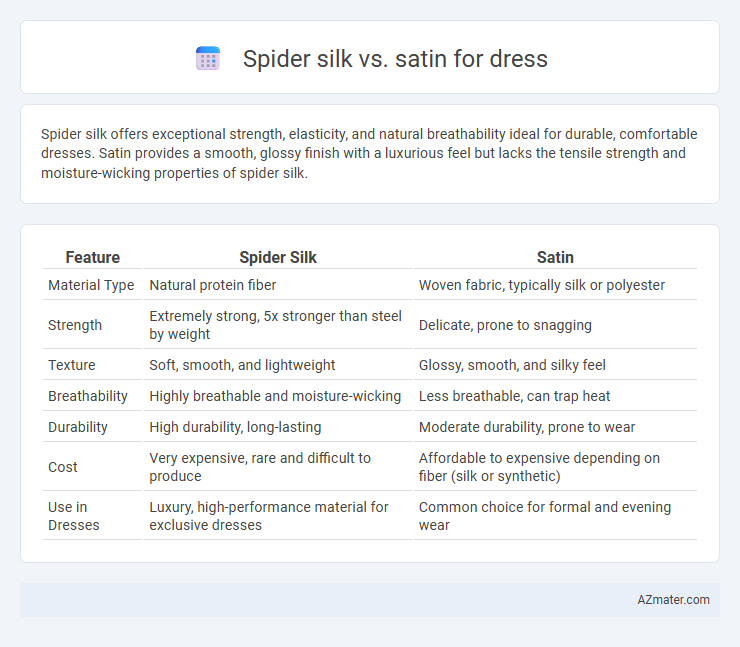Spider silk offers exceptional strength, elasticity, and natural breathability ideal for durable, comfortable dresses. Satin provides a smooth, glossy finish with a luxurious feel but lacks the tensile strength and moisture-wicking properties of spider silk.
Table of Comparison
| Feature | Spider Silk | Satin |
|---|---|---|
| Material Type | Natural protein fiber | Woven fabric, typically silk or polyester |
| Strength | Extremely strong, 5x stronger than steel by weight | Delicate, prone to snagging |
| Texture | Soft, smooth, and lightweight | Glossy, smooth, and silky feel |
| Breathability | Highly breathable and moisture-wicking | Less breathable, can trap heat |
| Durability | High durability, long-lasting | Moderate durability, prone to wear |
| Cost | Very expensive, rare and difficult to produce | Affordable to expensive depending on fiber (silk or synthetic) |
| Use in Dresses | Luxury, high-performance material for exclusive dresses | Common choice for formal and evening wear |
Introduction to Spider Silk and Satin
Spider silk, a natural protein fiber produced by spiders, boasts remarkable strength, elasticity, and lightweight properties, making it an innovative material for high-end fabrics. Satin, a weave characterized by its smooth, glossy surface, is traditionally made from silk, polyester, or nylon, offering a luxurious sheen and soft texture commonly used in dressmaking. Comparing spider silk and satin involves evaluating spider silk's superior tensile strength and biodegradability against satin's versatile appearance and affordability in fashion applications.
Origins and Production Processes
Spider silk originates from the natural protein fibers produced by spiders through specialized silk glands, spun into strong, lightweight threads via a complex biochemical process. Satin is a woven fabric traditionally made from silk fibers but now commonly produced with synthetic fibers like polyester or nylon, using a weaving technique that creates a smooth, lustrous surface by floating warp or weft threads over several yarns. The production of spider silk is a biological process involving natural secretion and solidification, while satin production relies on industrial weaving methods to achieve its characteristic sheen and texture.
Physical Properties Comparison
Spider silk exhibits exceptional tensile strength and elasticity, making it both durable and flexible compared to satin, which is smoother but less resilient. Satin's surface has a glossy finish due to its weave structure, offering a luxurious appearance, whereas spider silk's natural protein fibers provide superior moisture-wicking properties and lightweight breathability. The high tensile strength of spider silk surpasses that of satin, contributing to enhanced durability and tear resistance in dress materials.
Texture and Feel: Spider Silk vs Satin
Spider silk offers a unique combination of softness and strength, providing a smooth yet slightly textured feel that adapts to body movement with exceptional breathability. Satin, typically made from silk or synthetic fibers, delivers a glossy, smooth surface that feels cool and luxurious against the skin but can lack the natural elasticity of spider silk. The natural protein structure of spider silk contributes to its lightweight and moisture-wicking properties, distinguishing its texture and comfort level from the sleek, often heavier finish of satin fabrics.
Durability and Longevity
Spider silk offers exceptional durability and longevity due to its remarkable tensile strength and natural elasticity, making it highly resistant to wear and tear over time. Satin, typically made from silk or synthetic fibers, provides a smooth finish but is more prone to snagging and less resilient under frequent use. For dress materials prioritizing long-lasting quality, spider silk consistently outperforms satin in maintaining structural integrity through extended wear.
Breathability and Comfort
Spider silk offers superior breathability and moisture-wicking properties compared to satin, making it ideal for dress materials in warm climates. Its natural protein fibers regulate temperature efficiently, ensuring enhanced comfort throughout wear. Satin, often made from synthetic fibers like polyester, tends to trap heat and moisture, reducing airflow and causing discomfort during extended use.
Color and Luster Differences
Spider silk possesses a natural iridescent sheen that reflects light with a subtle, dynamic luster, enhancing color depth and richness in dresses. Satin features a smooth, glossy surface with a consistent and bright shine, creating a more uniform and vibrant appearance across various colors. The unique optical properties of spider silk produce a softer, variegated shimmer, while satin's weave delivers a high-gloss finish that intensifies color saturation.
Sustainability and Environmental Impact
Spider silk is a biodegradable, renewable protein fiber produced by spiders with minimal environmental impact, requiring no harmful chemicals or excessive water use in its production. Satin, typically made from synthetic fibers like polyester, relies on petroleum-based materials, contributing to pollution, non-biodegradability, and increased carbon emissions during manufacture. Choosing spider silk dresses supports sustainability through eco-friendly production processes and reduced waste compared to traditional synthetic satin fabrics.
Cost and Accessibility
Spider silk, known for its exceptional strength and lightweight feel, remains prohibitively expensive and difficult to source due to its labor-intensive harvesting process and limited production scales. Satin, typically made from synthetic fibers like polyester or natural ones such as silk, offers a more affordable and widely accessible alternative for dress fabric, available in numerous retail outlets and offered at various price points. The high cost and rarity of authentic spider silk limit its use in mainstream fashion, whereas satin's versatility and competitive pricing make it the preferred choice for most consumers.
Best Applications for Dresses
Spider silk is renowned for its exceptional strength, flexibility, and lightweight nature, making it ideal for high-performance and luxury dresses that require durability and comfort. Satin offers a smooth, glossy finish with excellent drape and sheen, perfect for elegant evening gowns, bridal wear, and formal dresses emphasizing aesthetic appeal and softness. Dresses crafted from spider silk excel in breathability and resilience for active or avant-garde fashion, while satin suits traditional, glamorous designs that prioritize visual impact and softness against the skin.

Infographic: Spider silk vs Satin for Dress
 azmater.com
azmater.com